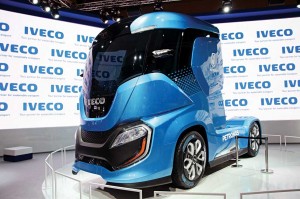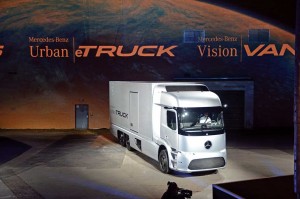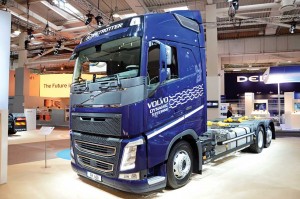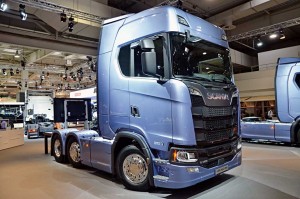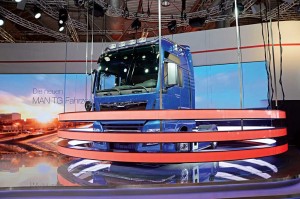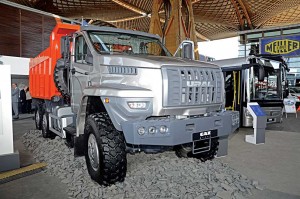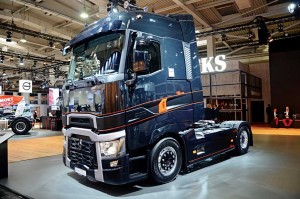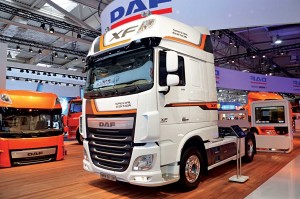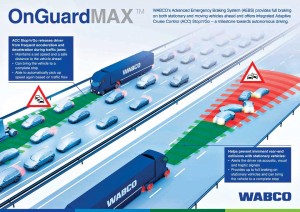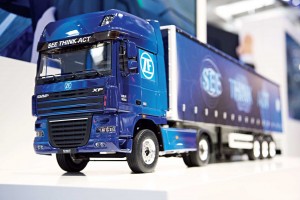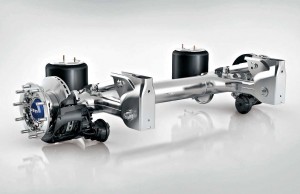The 66th IAA Commercial Vehicle show 2016 reflected the change the commercial vehicle industry is going through.
Story by: Anirudh Raheja
Photos by: Gianenrico Griffini
The 66th IAA Commercial Vehicle show opened its doors to visitors on the morning of September 21, 2016, at Hannover in Germany. The weather on that particular day was pleasant, though a little cold by Indian standards. One of the biggest fair facilities in Germany, Hannover Messe, spread over 2.7 lakh sq. m., attracted 2,013 exhibitors from 52 countries to the show. People from commercial vehicle industry the world over flocked to the premier show. They were not disappointed. The 66th IAA CV show shed light on electromobility, a digital future and urban logistics. The show highlighted the efforts being taken towards an efficient, safe, comfortable and greener tomorrow. It particularly emphasised on innovative solutions to reduce fuel consumption of CVs, and in-turn reduce the carbon footprint. The all new connectivity solutions (fleet management programmes, navigation, and advanced maintenance services, etc.) on display looked promising and will improve road transport efficiency. The focus of Original Equipment Manufacturers (OEMs)was on trying to optimise the advanced diesel engine drivelines. It was on introducing alternative drivelines, including gas engines and electric motors. Over 332 world premiers took place at Hannover. Of these, 100 were Europe-centric. Over 70 per cent of the world premiers were by suppliers. Over the nine days of the show, a whopping 2.45 lakh people visited it.
Iveco Z
Perhaps the most exciting debut at the IAA show was the Iveco Z truck. A true reflection of a greener tomorrow, Iveco like others is also relying on on advanced diesel drivelines and gas engines in a bid to reduce the carbon footprint,fuel consumption and the Total Cost of Ownership (TCO) associated with road transport. The Z, holding over 29 patents, is a zero impact concept long-haulage truck. With improved combustion and reduced friction, the Z uses an ultra low viscosity oil. A bio methane LNG powertrain propels the Z truck. Rated power is 460 hp and peak torque is 2,000 Nm. Transmission is a 16-speed auto unit with powershift in upper gears. Delivering zero CO2 emissions, the Z truck has been developed closely in association with Petronas for low viscosity oils and Michelin for tyres featuring RFID tags and pressure monitoring system senors. The LNG tank optimises space even as the extreme geometry changes on the tractor reduce the drag co-efficient by over 30 per cent. The on-board Rankie Cycle system uses exhaust gases as a heat source to recover energy. Fully loaded with active and preventive safety technologies that facilitate automated driving, the Z truck also gets a driver-centric cab design that can be reconfigured according to various activities in a day to maximise driver’s productivity and comfort.
Mercedes-Benz Urban eTruck and Fuso eCanter
Mercedes-Benz is pursuing the reduction in fuel consumption with the latest generation of OM 471 six-in-line 12.8 litre diesel engine and, for the next decade, is relying on pure electric trucks. Premiering at the show, the Mercedes-Benz all-electric Urban eTruck claims to match the performance of a diesel engine. It’s a different approach compared to the last few years when Daimler seemed interested in developing a hybrid driveline (diesel engine coupled with an electric motor) for medium duty distribution trucks (Atego Hybrid) instead. The 26-tonne GVW triple axle Urban eTruck is powered by a 212 kWh Lithium-ion modular battery pack developed by Mercedes-Benz Energy GmbH. A zero emission vehicle, the truck can cover up to 200 km on one charge, which is ample for a heavy-duty short radius distribution sector. The electrically powered rear axle of the Urban eTruck is coupled with electric motors placed adjacent to wheel hubs. Their maximum output is 2×125 kWh, and they generate a torque of 2×500 Nm. Operating in three different modes, ‘auto’, ‘agile’ and ‘eco’ according to the target range, and to optimise the use of energy, the eTruck features predictive powertrain control, cruise control, predictive charge management and FleetBoard telematics for extended application reach. These features also help to complete the planned haulage without deploying extra fleet. The central display shows a wide range of information to the driver. The driver is also provided with a tab to regularly update himself with detailing on the range and the battery status.
The Fuso eCanter that premiered at Hannover is equipped with water-cooled lithium ion battery pack. The pack has five units, two on each side of the frame and one centrally located in the frame right behind the cab for weight balancing. With a 70kWh capacity, the eCanter can cover a range of 100 km in one juice. The battery is fully adaptable with two charging options using a standard Combo 2 plug. Up to 80 per cent battery charge up can be achieved in less than an hour at a quick charging station and 100 per cent charge in up to seven hours on AC current. The synchronous electric motor of eCanter has an output of 185 kWh and a torque of 380 Nm. Power transfer to the rear axle of eCanter is managed by single speed transmission.
Volvo FH facelift
Volvo Trucks unveiled an optimised version of the Volvo FH. It also unveiled the Volvo FH ‘Performance’ model. The Volvo FH will now be available with an improved Euro VI compliant D13 engine coupled to Volvo’s I-Shift transmission. Featuring improved aerodynamics for an improvement in fuel economy of up to three per cent, the Volvo FH will have its 420 hp and 460 hp variants come with a high pressure common-rail injector to support a higher compression ratio. This is in part to the introduction of a new turbocharger on the 500 hp FH and the 520 hp FH. The special edition, Volvo FH ‘Performance’ truck is a 4×2 tractor with D13 engine that generates 540 hp, and is coupled to an I-shift dual AMT transmission. The tractor also comes equipped with Volvo Dynamic Steering and independent front suspension to offer superior comfort for long haul drivers. Celebrating a decade and a half long journey of riding with its much acclaimed I-shift technology, the company claims that a whopping 92 per cent of its trucks sold in the world are equipped with I-shift technology. In case of its European range, this figures elevates itself further, to 95 per cent. The Swedish giant has recently introduced the I-shift transmission with crawler gears, which offer better start to trucks with heavy loads even in severe situations. “For heavy operations such as timber haulage, the savings may be even higher if the engine is combined with I-Shift transmission having Crawler Gears, and Tandem Axle Lift,” said Claes Nilsson, President, Volvo Trucks. A faster rear axle enables the truck to move at higher average speeds at lower engine revs.
Scania showcases the new S and R
Post the unveiling of the new S and R series at Paris last month, Scania got them to Hannover so that the visitors at the show got an opportunity to see them. The flagship S series heavy-duty tractor, which won the International Truck Of the Years award, was one of the four Scanias showcased at the IAA fair as part of the next generation range. The new truck range, between the S and the R series, gets in-house designed cabs and more efficient powertrains. The new cabs are designed to offer utmost comfort to the occupants, and offer a plethora of features including a flat floor, increased ceiling height, ergonomically designed four entry steps and improvised sitting dimensions of 65 cm. Available with side curtain airbags as an option, the beauty of the new generation Scania trucks is the car-like drive they offer. The seating optimisation was carried out by pushing the windshield forward. The shift to the side resulted in optimised road vision. A total of 24 variants are available between the S and the R series. Apart from features like curtain airbags, the trucks also offer customised climate control system. The new, 13-litre 500 hp, inline Euro VI engine that is one of the many powertrains that the new generation truck range will be powered with, a three per cent fuel saving is attributed to a change in engine technology. Two per cent fuel saving is through superior aerodynamics. The truck range also features a new layshaft brake system that cuts gear change time by 0.4 seconds, and improves overall efficiency and performance. The Citywide LE bus that Scania displayed is a hybrid version of Citywide LE bus, gas engine backed Interlink HD and standard Scania Interlink HD bus. Scania announced the Flexible Maintenance Plans for its trucks at the show..
MAN TGE transporter
MAN unveiled the TGE transporter at the show. The truck offers a payload capacity of up to 1.5-tonne. The GVW ranges between 3- and 5.5-tonne. TGE gets a completely new two-litre turbo-diesel engine with the option of a six-speed manual or eight-speed automatic transmission. Features of the TGE include Emergency Brake Assist (EBA), which uses digital sensors to shed speed automatically. The Munich-based manufacturer also presented the optimised versions of D26 and D38 engines. Designed to offer more torque, both the engines feature a reactive catalyst material for SCR system that enables combustion and exhaust gas treatment, which is optimised for reduced fuel consumption. MAN also showcased an electric tractor (eTruck), designed for inner-city night deliveries. MAN additionally spoke about the RIO platform at Hannover. This is an open platform that undertakes big data algorithms to offer improvements in logistic and transportation ecosystem. Fleet owners, even those that have a mixed fleet, will be able to use the common platform regardless of the telematics system or even the vehicle brand. Every information collected from the vehicle regardless of its type combines with the traffic data, weather condition, and navigation data to offer recommendations in real time.
Next generation CVs from GAZ
Russian CV giant GAZ showcased a slew of new generation trucks and buses at the IAA show. These included 3.5-tonne GVW dropside trucks and vans, 8.7-tonne GVW medium-duty trucks, 13 to 34-tonne GVW heavy-duty trucks with 4×4, 6×6, 8×8 application apart fro the small, medium and large class mini buses, inter-city and tourist coaches. Designed to handle extreme road conditions, and ensure stability under maximum load and climate conditions, the range at the show that GAZ showed was versatile to say the least. The GAZelle Next, for example, is a frame-based dropside 5.5-tonne LCV powered by a Cummins ISF 2.8-litre diesel engine and a steering by ZF. The shock absorbers are Mando, and the adjustable steering column is of CSA Castellon. The GAZelle Next also features Sach clutch for better performance; an Eaton rear axle lock that significantly improves traction on dirty and slippery roads, and a dual circuit brake system that has front disc brake and enlarged pads. GAZ’s 8.7-tonne GVW medium-duty truck GAZon Next is designed for urban and inter-city routes. It is powered by YMZ-534 diesel engine that puts out 150 hp, and is well equipped with ZF steering and clutches, Tenneco shock absorbers and Delphi climatic systems. For driver comfort, the cabin comes equipped with anatomic driver seat with air suspension and five-way adjustment and lumbar support. Specially developed for tipper application, the Ural Next tipper is equipped with YMZ 536 engine that puts out 312 hp, and has a hydraulic tipping gear for a payload capacity of 10-tonne and a load volume of 10.5 cu m. The full time all-wheel drive is supported by adjustable-pressure tyres, locking axle differential in transfer box and wheel differentials of intermediate and rear axles. The Ural Next tipper is capable for over 400 modifications for a variety of applications including boom trucks, fuel tenders, fire engines and truck-based buses.
Renault showcases the High Edition
Renault Trucks displayed nine trucks at the IAA show, aimed at long hauls, construction and distribution segments. Renault also display its well acknowledged rally trucks. The highlight was a High Edition series in its T-High range. A version was displayed in the cut-away form so that the show goers could have a close look at the ergonomy, design and interiors of the vehicle. Renault Magnum’s successor, the T-High range is powered by a 13.0-litre common-rail engine that churns out 520 hp of power. Renault has added a flat-floor in its T-High range for stress free long haul journey. Features of the T-High range include leather steering wheel, arm rests, different lights for passageways and night driving, leather upholstery, and more. Other features include Fuel Eco+ pack for optimised consumption, roof mounted and side opening deflectors for better aerodynamics, adaptive cruise control, xenon highlights, additional indicator lights and GPS. The elegant black paintwork, aluminium wheels and carbon-look trim of the T-High truck at the show were appreciated by the show goers.
DAF Connect
At the show, DAF introduced the DAF Connect, a fleet management system. Enabling fleet optimisation, DAF Connect, apart from enhancing logistics efficiency, helps to focus upon driver performance for reduced cost of efficiency. The Live Fleet View feature brings necessary information that can enable optimal route planning and time scheduling. Operators can get self-defined alerts regarding deviations in location, speed, route and fuel consumption. To be made available from the fourth quarter of 2016, DAF Connect will also allow customers to take advantage of DAF’s tailor-made services that allow transporters to chalk out repair and maintenance plans for their fleet upkeep. Announced Richard Zink, Director Sales and Marketing, DAF Trucks, that they are tying up with independent fleet management information suppliers to make the system an open platform. DAF showcased its innovation truck that illustrates next generation technologies including hybrid and electric. The company also spoke about its work in waste heat recovery, and connected and collaborative driving. Displayed at the DAF stall were optimised versions of the PACCAR 4.5-litre PX-5 and 6.7-litre PX7 engine that have been introduced in the DAF LF and CF series distribution trucks. The four-cylinders in-line turbocharged PX-5 inter-cooled diesel engine generates 210 hp and 850 Nm torque at 1,200-1,500 rpm. The six-cylinder in-line turbocharged inter-cooled PX-7 diesel engine puts out 325 hp, and a peak torque of 1,200 Nm at 1,100-1,700 rpm..
WABCO launches OnGuardMax
Elevating safety, efficiency and connectivity, Wabco Holdings Inc., launched OnGuardMAX, an advanced emergency braking system (AEBS) for buses and trucks. Aimed at further enhancing automated driving, the system is equipped with a high resolution camera, and supported in turn by a 77 GHz radar. Capable of performing even in low visibility conditions, the AEBS alerts the driver with visual, acoustic and haptic warnings. It applies full brakes (even on highway) when it notices moving or stationary vehicles ahead in case the driver does not respond to the warnings. Derived out of Wabco’s OnGuard collision mitigation system, OnGuardMAX is also equipped with Adaptive Cruise Control (ACC) with Stop ‘n’ Go functionality to attain pre-set speed and maintain safe distance from the vehicle around. Wabco also unveiled OnHand, a stand-alone electro-pneumatic parking brake control for trucks and buses. With only three internal valves and reduced pneumatic piping over conventional parking brake controls, it increases flexibility of installation. Enabling back-up braking in the case of electrical service-brake failure, OnHand allows related options, Advanced Hill Start aid for inclined roads, and Anti-Lock Braking System for secondary braking. Reiterating its commitment to save pedestrians and cyclists in city traffic, Wabco displayed its OnCity Urban Turning Assist system, a single sensor system based on LiDAR technology. OnCity Urban Turning Assist system can detect nearby objects in the view of up to 180 degrees, and especially those that are located in vehicle blindside. The system sends out acoustic alerts for the driver to protect anything that comes dangerously close to the truck, either before or during a turn.
ZF Innovation truck 2016
ZF showcased the Innovation Truck 2016 equipped with driving assist systems. The truck is engineered with the world’s first brake assist and related emergency steering controls for heavy commercial vehicles. The Innovation Truck 2016 networks Highway Driving Assist (HDA) system and Evasive Maneuver Assist (EMA) system. The former makes sure the vehicle stays on road and avoid consequences resulting from distractions or lack of attention. The latter detects if the driver has applied brakes. In case a collision is unavoidable, MEA takes over both the tractor and trailer towards a hard shoulder or free lane riding steering motion of the driver. It is also equipped with SafeRange manoeuvring system that can boost vehicle’s efficiency at terminals. Post the acquisition of TRW in 2015, ZF has stepped up its range of mechatronic systems significantly. In August 2016, ZF acquired a 40 per cent stake in Ibeo, a German sensor expert which leads in the development of LIDAR systems for vehicle safety. At the show, ZF announced that it will be setting up a technical centre at Hyderabad with an investment of up to USD 34 million. The centre will develop advanced software and electronics, and is expected to house 2,500 engineers by the year 2020.
Tailormade solutions from BorgWarner
An updated portfolio for commercial diesel engines at the show for both heavy duty and light duty applications was presented by BorgWarner. The company presented new exhaust gas recirculation (EGR) modules that integrates EGR cooler, EGR valve and bypass valve into a single system that optimises exhaust gas recirculation and enhances efficiency. Offering tailor made solutions for various powertrain applications like low pressure and high-pressure EGR systems, BorgWarner showcased a system where the EGR cooler is built with corrosion resistant stainless steel hybrid or corrugated tubes, and optimises heat transfer. The EGR valves and actuator technologies offer high flow capability and minimise corrosion. The controlled coolant pump that BorgWarner displayed at Hannover reduces parasitic losses which optimises engine temperature and improves fuel economy by one and a half per cent when compared with a standard coolant pump. It also boasts electronic viscous drive and high modulation capabilities including performing optimally regardless of engine speed for better economy.
Allison aims at fuel efficiency
US-based transmission maker for medium to heavy-duty commercial vehicles, Allison displayed xFE technology and FuelSense with the promise of improving fuel economy in commercial vehicles. The xFE technology is claimed to save up to seven per cent fuel in city and transit buses where constant shifting of speed is involved. The software and electronically controlled FuelSense can reduce fuel consumption by up to 20 per cent for increased efficiency. Riding its patented Continuous Power Technology, Allison uses a torque converter that delivers full power shifts and better acceleration. Using automatic transmission, Allison promises minimise power loss that happens in manual or Automated Manual Transmission (AMT), and deliver better control over a vehicle.
JOST extends its portfolio
JOST displayed trailer axles developed under the JOST brand in collaboration with Mercedes-Benz. It signalled JOST’s acquisition of Mercedes-Benz Trailer Systems, which would make it one of the largest trailer axle manufacturers in Europe. Specially developed for silo trucks and tankers, the JSK 34 sensor coupling version of ultralight JSK 34 fifth wheel coupling premiered at the show. The comprehensive range of JOST products on display at the IAA CV show included a range of landing gears, including the Modul E-Drive landing gear, which has been developed especially for applications where frequent coupling and decoupling of trailer is involved. The gear reduces height difference between trailer and axles using pneumatic suspension of the vehicle and is operable with a button.
Modular lamp series for CVs by Hella
Hella showcased the modular lamp series for commercial vehicles. It is called the Shapeline series, and includes tail lights, brake lights, position lights and direction indicators in two different design lines, classic straight line style and dynamic curved style. Multi-volt ready (12-volt and 24-volt), the modular lamp series is supported by an online configurator, which allows designers and engineers to select different lighting modules for their CVs. The design can be handed to Hella for further development. The configurator accepts current European ECR R48 regulations or American SAE regulations.
Continental
Continental unveiled ‘ContiConnect’, a tyre information and management system that not only monitors, but also analyses and reports tyre pressure and temperature with its ContiPressureCheck Sensors. If needed, the online portal can also offer corrective measures to the fleet, and will be launched in the second quarter of 2017 in the key Asia-Pacific markets, America markets and Europe markets.
Cummins
Leading engine manufacturer Cummins displayed its heavy duty X12 (12-litre) and X15 (15-litre) engines at Hannover. These engines are designed to meet 2017 EPA-GHG regulations in North American markets, and are Euro VI compliant for worldwide regulations. The company also premiered the G series platform in the form of an in-line six-cylinder 11- and 12-litre engine. The G series engines meet stringent Euro emission regulations. The ISG12 engine does 500 hp and 2300 rpm of peak torque.Demonstrating its prowess, Cummins also displayed new engine component technologies like the mid-range fuel system and CompactBox after-treatment solution.
Bridgestone
Bridgestone demonstrated its innovative Tirematics tyre monitoring system at the IAA Commercial Vehicles 2016 show. Tirematics encompasses all of Bridgestone’s connected tyre solutions; essentially IT systems that use sensors to remotely monitor, transmit and analyse real-time information, such as the pressure and temperature of commercial truck and bus tyres. The Tirematics fleet solution provides added value to fleet operators by taking a proactive approach to tyre maintenance, before serious problems arise. It also helps to reduce vehicle downtime and roadside breakdowns, while optimising tyre life and fuel economy. “Bridgestone’s Tirematics is a practical, cost effective fleet oriented solution with great impact on tyre performance, fuel economy and breakdown prevention” said Neil Purves, Senior Manager Solution Business Systems, Bridgestone Europe.
Delphi next-gen modular CR system for CVs
At the IAA show at, Delphi unveiled an ultra-high precision, modular fuel injection system that builds on the company’s proven Euro VI common rail technology. Promising substantial improvement in emissions, fuel economy and refinement while maintaining exceptional reliability, at the heart of the system is a ground-breaking injector that provides the control unit with real-time information on the operation of the injector. The system has no additional wires and requires no extra interfaces or packaging space. Data from the injector allows the implementation of closed loop control that continuously monitors and optimises injection events to compensate for changing conditions, including wear as the vehicle ages. The closed-loop system eliminates injector calibration to accommodate drift over use. Smaller injection events can be specified while the system eliminates the need to scan the injector characterisation code when an injector is fitted. Capable of covering both heavy duty and medium duty engines, the modular system allows applications from 0.7 litres per cylinder up to 3.0 litres per cylinder and beyond. Particular attention has been paid to materials selection and validation across all known global fuel specifications, allowing application worldwide.
Future tech from Bosch
Bosch displayed large displays and touchscreens that find use in truck for functions like priority warnings. The innovative neoSense touchscreen gives users haptic feedback, and the touchscreen buttons feel real so the drivers can operate them without looking. Simple operation, intuitive menu navigation and less distraction are the benefits. The displays and screen can be integrated with smartphones. The camera-based solution from Bosch at IAA show completely replaces OVRMs. Called the Mirror Cam System, the solution reduces wind resistance and saves fuel. The video sensors can be integrated into the driver’s cab; on the highway the driver can see further behind the vehicle. The connectivity control unit (CCU) is a central connectivity solution for CVs, and communicates via a wireless module equipped with its own SIM card and can determine the vehicle’s position using GPS if desired. CCU is available both as OE and as a retrofit solution. The electronic horizon portfolio that Bosch is expanding, includes real-time data. It allows the engine and transmission management to take construction areas, traffic jams, or even icy patches into account and automatically adjust the vehicle’s speed in advance can further reduce fuel consumption, thereby increasing efficiency. Bosch also displayed app.-based secure truck parking, infotainment system for buses and eyes (camera) and ears (radar sensors) for assisted and automated driving.
Hendrickson focuses on lightweighting and comfort
Hendrickson Truck Commercial Vehicle Systems launched a rear-air suspension in a 9.5-tonne to 13-tonne single axle configuration, and 19-tonne to 21-tonne Tandem axle configuration. It is light in weight, durable and comfortable for highway applications. Claimed to facilitate weight savings of up to 50 per cent over a steel monoleaf spring, the use of an advanced composite spring material is claimed to facilitate fatigue durability. Luxair, a premium drive axle air suspension caters to the rapidly changing bus market. It utilises high volume air springs, and is claimed to deliver passenger comfort, superior handling, and less road-induced shock loads. The Softek NXT displayed, is a monoleaf suspension and steer axle system which caters to heavy-duty truck applications. Its lightweight design (5.4-5.7 tonne) is said to facilitate better fuel economy and payload capacity. The Steertek NXT is a fabricated front steer axle available in the range of seven- to 11 tonne. It is light-weight and durable. It makes a good alternative to the forged I-beam axle and saves 18 kg in comparison.
——————————————-
With inputs from Gianenrico Griffini




